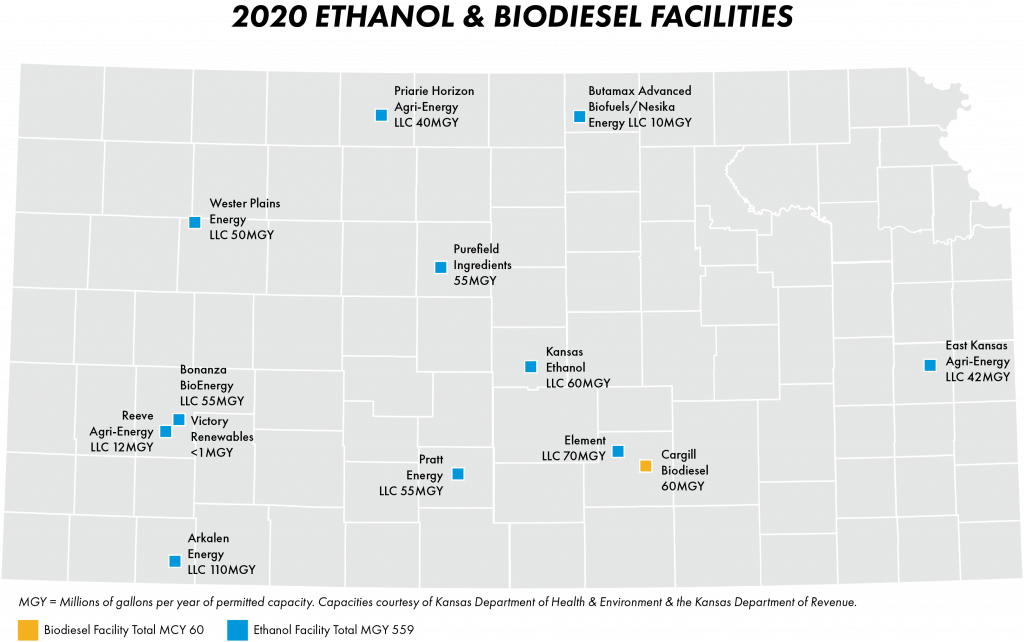With an ever-increasing percentage of the state’s energy coming from renewable sources, Kansas offers an immediate advantage to companies committed to meeting corporate sustainability goals. In 2019, wind energy surpassed coal for the first time as the largest energy source for generating electricity in Kansas. Wind energy provided 41% of electricity generation in Kansas, the second-largest share for any state.
Kansas offers a diverse portfolio of financial incentives to businesses and producers engaged in conventional and renewable energy production. State tax credits are available for projects that convert waste heat or biomass to energy, or otherwise offset local power usage via renewable sources. Numerous development incentives, including incentive payments, income tax credits, sales tax exemptions, financial assistance for training and property tax exemptions are available to producers, retail dealers and individuals that utilize alternative energy sources.
Wind: #1
source of electricity in Kansas
6,100
megawatts of installed wind generating capacity
#2
in the nation for share of wind power generation
Top 5
in total wind energy generation
Located in the heart of the nation’s Wind Corridor and ranked second in the nation for wind energy potential, Kansas wind generation has been skyrocketing. Kansas is committed to the growth of this industry through the development of additional wind farms and a strong supply chain. Kansas is among the top four states for operating wind farms, with over 6,100 MW of wind farms currently in operation, representing capital investment of $11.4 billion through 2019.
The state ranks third in corporate wind purchases, providing competitively priced wind energy and helping corporate purchasers such as Google, T-Mobile, Target, Kohler, Textron Aviation, and Spirit AeroSystems and others to meet their sustainability goals. Kansas is ideal for wind turbine component manufacturing, as well as service operations for maintenance of the thousands of wind turbines in and around the state. Our central location and outstanding transportation infrastructure provide convenient and economical access to the regions with the greatest wind energy activity. Siemens Gamesa Renewable Energy chose Kansas for its North American wind turbine nacelle production facility, citing transportation advantages, pro-business climate and state and local support. A Kansas location offers companies in the wind supply chain ideal access to the Siemens Gamesa nacelle plant and other manufacturers in the region.
Kansas has a great solar rating, and businesses have found the state to be an ideal location from which to serve the U.S. market. Companies also benefit from the state’s transportation network, predictable utility costs and reliable utility services.
The state’s strong workforce and customized training programs offer further advantages to solar equipment manufacturers and suppliers. Various educational institutions are creating specialized solar programs. Johnson County Community College has a Solar Learning Lab and offers an Electrical Technology certificate program and an Associate of Applied Science degree that includes training for solar photovoltaic installers.
Kansas ranks fourth in total biomass production, with companies benefiting from economical access to feedstock for bio-based fuels, as well as proximity to feedlots that serve as a market for the animal feed resulting from biofuel byproducts. With 3 million head of cattle on feed in southwest Kansas, biofuel plants can enjoy the cost savings of sending out wet distillers grains to nearby feedlots.
Kansas has 12 operating biofuel facilities, and additional ethanol and biodiesel facilities are being developed.

Kansas is home to industry leader ICM, which has designed and built many of the nation’s ethanol plants and was selected by the U.S. Department of Energy as one of four small-scale biorefinery companies to lead biomass-to-ethanol research efforts using innovative conversion technologies.
The petroleum industry is a major contributor to the economy of Kansas. Hundreds of thousands of oil and natural gas wells drilled in the state since the late 19th century have produced more than 6.7 billion barrels of oil and 41.2 trillion cubic feet of natural gas through 2018. The most recent information about Kansas oil and gas production is available on the KGS website.